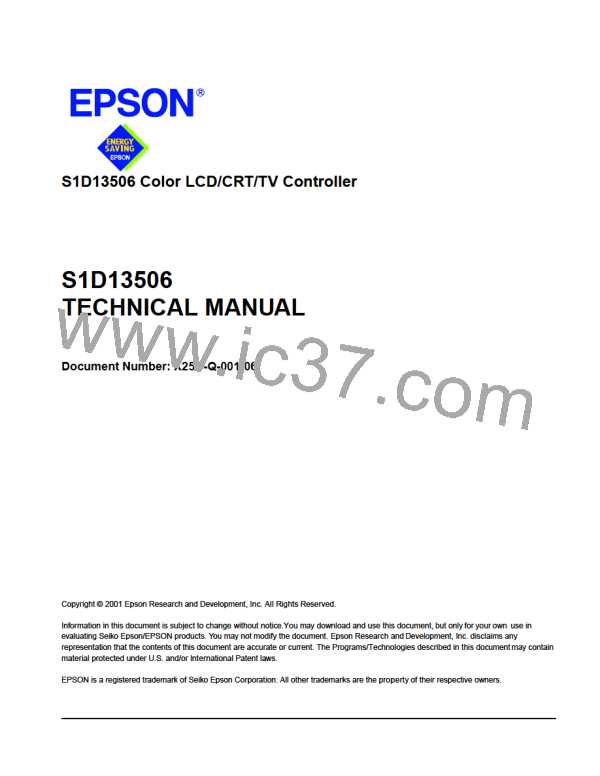Page 210
Epson Research and Development
Vancouver Design Center
16 EPSON Independent Simultaneous Display (EISD)
16.1 Introduction
EPSON Independent Simultaneous Display (EISD) allows the S1D13506 to display
independent images on two different displays (LCD panel and CRT or TV). The LCD panel
timings and mode setup are programmed through the Panel Configuration Registers
(REG[03Xh]) and the LCD Display Mode Registers (REG[04Xh]). The CRT/TV timings
and mode setup are programmed through the CRT/TV Configuration Registers
(REG[05Xh]) and the CRT/TV Display Mode Registers (REG[06Xh]). The Ink Layer or
Hardware Cursor can also be independently controlled on the two displays. The LCD
Ink/Cursor Registers (REG[07Xh]) control the Ink/Cursor on the LCD display; the
CRT/TV Ink/Cursor Registers (REG[08Xh]) control the Ink/Cursor on the CRT or TV.
Each display uses its own Look-Up Table (LUT), although there is only one set of LUT
Registers (REG[1E0h], REG[1E2h], REG[1E4h]). Use the LUT Mode Register
(REG[1E0h]) to select access to the LCD and/or CRT/TV LUTs.
The pixel clock source for the two displays may also be independent. Use the Clock Config-
uration Registers (REG[014h], REG[018h]) to select the LCD pixel clock source and the
CRT/TV pixel clock source, respectively. Typically, CLKI2 is used for the CRT/TV
display, while CLKI is used for the LCD display. Memory clock may come from CLKI or
BUSCLK.
To display different images on the LCD and CRT/TV, the two images should reside in non-
overlapping areas of the display buffer, and the display start addresses point to the corre-
sponding areas. The display buffer is mapped to the CPU address AB[20:0] linearly.
Example 1: Assuming a 2M byte display buffer, the LCD image may locate in the first 1M
byte of the display buffer (AB[20:0] = 000000h-0FFFFFh), and the CRT/TV
image may locate in the second 1M byte of the display
buffer (AB[20:0] = 100000h-1FFFFFh).
The LCD and CRT/TV may display identical images by setting the display start addresses
for the LCD and the CRT/TV to the same address. In this case only one image is needed in
the display buffer. However, the display pipelines are still independent so the same image
is fetched twice from the display buffer; once for the LCD refresh and once for the CRT/TV
refresh.
S1D13506
X25B-A-001-10
Hardware Functional Specification
Issue Date: 01/02/06

 EPSON [ EPSON COMPANY ]
EPSON [ EPSON COMPANY ]